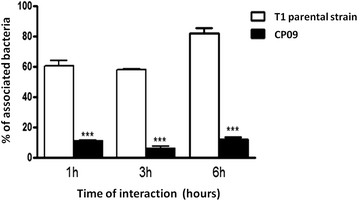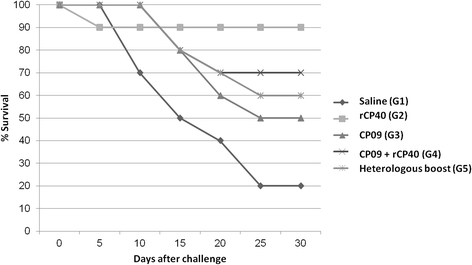Corynebacterium pseudotuberculosis cp09 mutant and cp40 recombinant protein partially protect mice against caseous lymphadenitis
- PMID: 25527190
- PMCID: PMC4297461
- DOI: 10.1186/s12917-014-0304-6
Corynebacterium pseudotuberculosis cp09 mutant and cp40 recombinant protein partially protect mice against caseous lymphadenitis
Abstract
Background: Caseous lymphadenitis (CLA) is an infectious disease that affects small ruminants and is caused by Corynebacterium pseudotuberculosis. This disease is responsible for high economic losses due to condemnation and trim of infected carcasses, decreased leather and wool yield, loss of sales of breeding stock and deaths from internal involvement. Treatment is costly and ineffective; the most cost-effective strategy is timely immunisation. Various vaccine strategies have been tested, and recombinant vaccines are a promising alternative. Thus, in this study, different vaccine formulations using a recombinant protein (rCP40) and the CP09 live recombinant strain were evaluated. Five groups of 10 mice each were immunised with saline (G1), rCP40 (G2), CP09 (G3), a combination of CP09 and rCP40 (G4) and a heterologous prime-boost strategy (G5). Mice received two immunisations within 15 days. On day 30 after primary immunisation, all groups were challenged with a C. pseudotuberculosis virulent strain. Mice were monitored and mortality was recorded for 30 days after challenge.
Results: The G2, G4 and G5 groups showed high levels of IgG1 and IgG2a; G2 presented significant IgG2a production after virulent challenge in the absence of IgG1 and IgG3 induction. Thirty days after challenge, the mice survival rates were 20 (G1), 90 (G2), 50 (G3), 70 (G4) and 60% (G5).
Conclusions: rCP40 is a promising target in the development of vaccines against caseous lymphadenitis.
Figures



References
-
- Seyffert N, Guimarães AS, Pacheco LG, Portela RW, Bastos BL, Dorella FA, Heinemann MB, Lage AP, Gouveia AM, Meyer R, Miyoshi A, Azevedo V. High seroprevalence of caseous lymphadenitis in Brazilian goat herds revealed by Corynebacterium pseudotuberculosis secreted protein-based ELISA. Res Vet Sci. 2010;88:50–55. doi: 10.1016/j.rvsc.2009.07.002. - DOI - PubMed
-
- Radostits OM, Gay CC, Hinchcliff KW, Constable PD. Veterinary Medicine: A textbook of the diseases of cattle, horses, sheep, pigs, and goats. Philadelphia: Saunders; 2007.
-
- Smith MC, Sherman DM. Goat Medicine. Lippincott Williams: Baltimore; 1994.
Publication types
MeSH terms
Substances
LinkOut - more resources
Full Text Sources
Other Literature Sources

